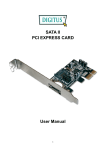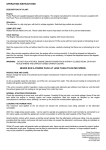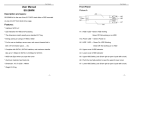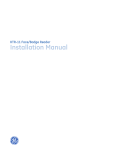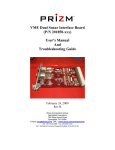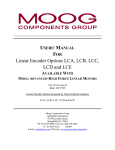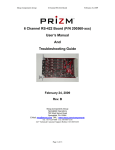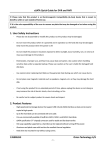Download 200530-xxx Fiber Optic Modem Manual rev. G
Transcript
Moog Components Group Fiber Optic Modem Rev. G February 24, 2009 Fiber Optic Modem Board (with Diagnostics) Part Number 200530-xxx User’s Manual And Troubleshooting Guide February 24, 2009 Rev. G Moog Components Group Springfield Operations 750 West Sproul Road Springfield, PA 19064 E-Mail: [email protected] URL: www.moog.com/components Tel: 610-328-4000 Fax 610-605-6216 24/7 Technical Customer Support Hotline: 610-605-6101 Page 1 of 14 Moog Components Group 1 Fiber Optic Modem Rev. G February 24, 2009 Fiber Optic Modem Board, Part Number 200530-xxx ........................................................................... 3 1.1 Modem Board Revision History:.................................................................................................... 4 1.2 Modem Board Dash (-) Number Definitions:................................................................................. 6 1.3 Modem Board Operation: ............................................................................................................... 7 1.3.1 Modem Board Indicators and Connections: ........................................................................... 8 1.3.2 Modem Board Specifications: .............................................................................................. 10 1.3.3 Modem Board Dimensions: .................................................................................................. 10 1.3.4 Modem Board Power Requirements:.................................................................................... 10 1.4 Modem Board and Fiber Troubleshooting.................................................................................... 11 1.4.1 Board Level Testing ............................................................................................................. 11 1.5 Possible System Problems, Diagnosis and Fixes.......................................................................... 12 Page 2 of 14 Moog Components Group Fiber Optic Modem Rev. G February 24, 2009 1 Fiber Optic Modem Board, Part Number 200530-xxx The Fiber Optic Modem board sends and receives digital data streams via fiber optic links from an opposing Fiber Optic Modem board. The Modem provides all of the timing and control functions, the high-speed link interface, data formatting for transmission, clock and clock recovery for reception, and parallel bus interface for the rest of the system boards. The Modem board comes with fiber optic transmitter (a laser device) and receiver modules attached. 1.5Gbp optics is used in the standard configuration but other data rates are available. The fiber optic transmitter and receiver modules have fiber optic pigtails with optical connectors that are plugged into optical couplers mounted on the board and set back approximately 25mm (1 inch) from the front faceplate. The customer’s field optical cables are plugged into these couplers. The couplers are typically ST single mode type but FC and SC are available optionally. The fiber pigtail on the transmitter laser module is 9 micron singlemode while the pigtail on the receiver is 50 micron multimode. The fiber optic data link transmitter and receiver chips must have a full duplex connection in place (i.e. two way communications must be established) before multiplexed data is sent over the link. If only one direction is operational, synchronization characters are sent instead of data. Note: Both fiber optic cables (TX and RX) must be in place for the Prizm multiplexer to operate correctly. The Fiber Optic Modem Board has been re-designed to include hardware and firmware for monitoring various parameters of interest. This capability is accessed via a 2 pin Phoenix connector on the front panel that carries bi-directional RS-485 telemetry to the modem. The diagnostics modem will typically be used in conjunction with a user-supplied PC on the surface, which has been loaded with PRIZM MODEM Monitoring S/W. Page 3 of 14 Moog Components Group Fiber Optic Modem Rev. G February 24, 2009 The diagnostics feature in no way interferes with normal operation of the modem – it is not necessary to be running the diagnostics s/w for the modem to work. Communication with the subsea modem is achieved through either a high-speed bit on the backplane or through a RS-485 Submux channel on an available interface card. NOTE: A modem configured for diagnostics over the backplane is NOT compatible with a modem that carries diagnostic data across the optic link using a RS-485 Submux data channel. In systems where the diagnostic data is carried over a high-speed bit on the backplane, it is not necessary to wire to the 2-pin Phoenix connector on the subsea modem. Data is carried from the 2-pin Phoenix connector on the surface modem, through the backplane and to the subsea modem. Refer to the Diagnostic Modem Command Structure for External Interface Users’ Manual for more details regarding the correct wiring scheme for specific applications. 1.1 Modem Board Revision History: The Modem board has gone through the following printed circuit board (PCB) and Assembly revisions: PCB Revision A/Assembly Revision A Original design. PCB Revision A/Assembly Revision B Incorporates the following ECOs: ECO20000620 Changed R75 value from 470 to 1K ohms Added Voltage Ref IC0076 between R75 (right pad) and U19 pin 3 Added wire between U19 pin1 and T27 Added wire between R75 (right pad) and U28 pin 22 ECO20000710 Changed value of R42 from 470 to 4.7K ohms Changed value of R41 from 1K to 10K ohms Removed R54 Added wire from T22 to T31 Added wire to connect pins 4,5,6 & 7 on U30 ECO20000814 Changed Polarity of –5V led ECO20000817 Removed R10, R14 and jumper JP11 PCB Revision A/Assembly Revision C Incorporates the following ECO: ECO20001205B Changed C27 and C30 from CS0065 to CS0080 to eliminate field problems with interference when inserting card in rack. PCB Revision A/Assembly Revision D Voided PCB Revision A/Assembly Revision E Incorporates the following ECO: ECO200530-002 Implemented multiple changes to improve RX Power monitoring, add TX power monitoring, add packet error monitoring and allow for interface with APD receivers. Page 4 of 14 Moog Components Group Fiber Optic Modem Rev. G February 24, 2009 PCB Revision A/Assembly Revision F Incorporates the following ECO: ECO200530-003 Disabled PER monitoring, removed shunt on Lattice. PCB Revision A/Assembly Revision G Incorporates the following ECO: ECO200530-004 Changed R13 and R58 from RS0137 to RS0169 to decrease gain in the TX power monitoring circuit from 20:1 to 10:1 PCB Revision A/Assembly Revision H Incorporates the following ECO: ECO200530-005 Changed U8 from IC0023 to IC0187 to increase stability of clock drive at high temperatures. PCB Revision B/Assembly Revision A Never released. PCB Revision B/Assembly Revision B Original design. Page 5 of 14 Moog Components Group Fiber Optic Modem Rev. G February 24, 2009 1.2 Modem Board Dash (-) Number Definitions: The Modem board has several dash numbers appended to the part number. These dash numbers identify specific board configurations: -004 1.0Gbps, 1310 nm laser wavelength, ST optical connectors -005 1.0Gbps, 1550 nm laser wavelength, ST optical connectors -006 1.5Gbps, 1310 nm laser wavelength, ST optical connectors -007 1.5Gbps, 1550 nm laser wavelength, ST optical connectors -009 600Mbps, 1310 nm laser wavelength, ST optical connectors, 1G Optics -010 600Mbps, 1550 nm laser wavelength, ST optical connectors, 1G Optics -011 1.5Gbps, 1310 nm laser wavelength, ST optical connectors, SIMPLEX -012 1.5Gbps, 1550 nm laser wavelength, ST optical connectors, SIMPLEX -013 600Mbps, 1310 nm laser wavelength, ST optical connectors, 1.5G Optics -014 600Mbps, 1550 nm laser wavelength, ST optical connectors, 1.5G Optics -015 1.5Gbps, 1510 nm laser wavelength Laser (SC), APD Receiver optical connectors -016 1.5Gbps, 1530 nm laser wavelength Laser (SC), APD Receiver optical connectors -017 1.5Gbps, 1550 nm laser wavelength Laser (SC), APD Receiver optical connectors -018 1.5Gbps, 1570 nm laser wavelength Laser (SC), APD Receiver optical connectors -021 1.5Gbps, 1510 nm laser wavelength, ST optical connectors -022 1.5Gbps, 1530 nm laser wavelength, ST optical connectors -023 1.5Gbps, 1570 nm laser wavelength, ST optical connectors -024 1.5Gbps, 1470 nm laser wavelength, ST optical connectors -025 1.0Gbps, 1310 nm laser wavelength, ST optical connectors, Video 2 -026 1.0Gbps, 1510 nm laser wavelength, ST optical connectors, Video 2 -027 1.5Gbps, 1550 nm laser wavelength, ST optical connectors, APD receiver -028 1.5Gbps, 1510 nm laser wavelength, ST optical connectors, APD receiver -029 1.5Gbps, 1510 nm laser wavelength, ST optical connectors, diagnostics through backplane -030 1.5Gbps, 1550 nm laser wavelength, ST optical connectors, diagnostics through backplane -031 1.44Gbps, 1550 nm laser wavelength, ST optical connectors -032 1.44Gbps, 1550 nm laser wavelength, ST optical connectors -033 1.0Gbps, 1310 nm laser wavelength, ST optical connectors -034 1.0Gbps, 1550 nm laser wavelength, ST optical connectors -035 600Mbps, 1550 nm laser wavelength, ST optical connectors -036 600Mbps, 1510 nm laser wavelength, ST optical connectors -037 600Mbps, 1530 nm laser wavelength, ST optical connectors -038 600Mbps, 1570 nm laser wavelength, ST optical connectors Page 6 of 14 Moog Components Group Fiber Optic Modem Rev. G February 24, 2009 1.3 Modem Board Operation: The Modem board interfaces to all the peripheral boards, as shown in the block diagram below. The transmit path is defined as the data flow direction from the peripheral boards over the backplane to the Modem board for transmission over the serial link, to the remote system. The receive path is from the remote system, through the modem, onto the backplane, to the peripheral boards. When transmitting, the Modem board takes in all the various data and video signals from the Prizm system’s peripheral boards and converts them to a single laser generated light signal, which is transmitted to the Prizm system at the other end of the fiber optic link. When receiving, the Modem board accepts the laser light signal from the other end of the fiber optic link converts it back to the original data and video signals and directs the reconstituted signals to the various peripheral boards in the Prizm system. Modem board operation is not effected by the Diagnostics capability. Refer to the PRIZM MUX Monitor User’s Manual for details concerning the set-up and use of the diagnostics s/w package. Refer to the Diagnostic Modem Command Structure for External Interface for details concerning the command structure required to communicate with the diagnostics capability of the modem. The Prizm Fiber Optic Video/Data Multiplexer Video 3 System is designed to carry video and data signals over a fiber optic cable at distances of up to 20 kilometers at a link rate of 1.5 gigabits per second (Gbps). The function of the Multiplexer is to partition the total system bandwidth into usable sub-bandwidths for use by the peripheral boards Page 7 of 14 Moog Components Group Fiber Optic Modem Rev. G February 24, 2009 1.3.1 Modem Board Indicators and Connections: There are six LED indicators on the front panel of the Modem board: +5, -5, PWR, TEMP, LOC, and REM. The green +5 LED (p/o LED1) indicates the +5 VDC status of the board and is lit GREEN when +5VDC is available via the backplane. The green –5 LED (p/o LED1) indicates the –5VDC status of the board and is lit GREEN when -5VDC is available via the backplane. The remaining LEDS are controlled via the on-board microcontroller that is part of the diagnostics capability. If the microntroller fails the status of these may not be indicative of actual status. NOTE: The diagnostics feature in no way interferes with normal operation of the modem – it is not necessary to be running the diagnostics s/w for the modem to work. The PWR LED (p/o LED2) indicates the +5VDC and –5VDC power status of the board. It is GREEN when both the +5VDC and –5VDC are within normal limits (absolute values from 4.9 to 5.2VDC), ORANGE when either is within warning limits (absolute values from 4.8 to 4.9 and 5.2 to 5.3 VDC) and RED when either is outside the warning limits (absolute values <4.8 or > 5.3). The TEMP LED (p/o LED2) indicates the temperature status of the board. NOTE: The Temperature sensor is currently physically located next to the board heat sink and as such it is typically hotter (by about 12° Celsius) then the actual ambient temperature. It is GREEN when the reading is below 72°C, ORANGE when between 72 and 77°C, and RED when reading is 77°C and higher The LOC LED (p/o LED3) is GREEN when the local receiver is receiving valid data and it is an indication that the received power is of acceptable level. This LED is RED when the local receiver is not receiving valid data and is an indication of either too low received power or receiver in saturation. The optical receiver has an operation range of approximately –6dBm (saturation) to –25dBm (sensitivity); signal levels that fall outside this range will result in invalid data and cause the LOC LED to turn RED. The REM LED (p/o LED3) provides an indication of the other ends LOC LED; it is GREEN when the remote receiver is receiving valid data (received power is of acceptable level) and RED when the remote receiver is not receiving valid data (too low received Page 8 of 14 Moog Components Group Fiber Optic Modem Rev. G February 24, 2009 power or receiver in saturation). Obviously if the LOC LED is RED, the REM indication will turn RED as well since no status from the remote unit will be received. The 2-pin RT+/RT- connector provides the RS-485 connectivity to the on-board processor for diagnostics communications. The initial release of the Diagnostics feature will require that the user allow for the use of one RS-485 channel in the mutiplexer system for connectivity between the topside Diagnostic PC and the remote multiplexer. Two slots are cut in the faceplate to allow connection to the modem optical connectors (F/O TX and F/O RX which are recessed behind the faceplate. Page 9 of 14 Moog Components Group Fiber Optic Modem Rev. G February 24, 2009 1.3.2 Modem Board Specifications: Link Data Rate: System Frame Rate: Link Options: Fiber Options: Fiber Wavelengths: TX Optical Power: RX Optical Power: Link Lengths: (Approximate) 600 Megabits/sec (Mbps) to 1.5 Gigabits/sec (Gbps) 25 Mega samples/sec (Msps) to 62.5 Msps Fiber Optic Singlemode or Multimode 1310, 1550 nanometers standard, other wavelengths available 0 dBm transmitter power output, typically -25dBm receiver sensitivity 20 kilometers with singlemode at 1.5 Gbps 4 kilometers with multimode at 600 Mbps 1.3.3 Modem Board Dimensions: VME 3-U printed circuit board (PCB): 100 mm wide x 160 mm long x 15 mm high (3.937 in x 6.299 in x .6 in) VME 3-U PCB and faceplate in rack: 15 mm wide x 128 mm high (.6 in x 5.05 in) 1.3.4 Modem Board Power Requirements: +5VDC at 2.0 Amps (10.0 Watts) -5VDC at .1 Amps (.5 Watts) Page 10 of 14 Moog Components Group Fiber Optic Modem Rev. G February 24, 2009 1.4 Modem Board and Fiber Troubleshooting In normal operation all LED on the front panel should be green. 1.4.1 Board Level Testing If either of the +5VDC or –5VDC LEDs are not lit: (probably the other LEDs will not be lit as well) Is this a total multiplexer problem or just this board? o Verify status of power indicator LEDs on other boards If other boards don’t have power, check Power Supplies If other boards do have power, problem isolated to this board. If problem is just this board. o Verify Power at backplane connector If Power is available, check for power on board across C30, C31 or C32. If Power on board, check LED and associated circuitry If PWR LED is YELLOW or RED: Verify board level power using Diagnostics s/w Verify voltage readings at backplane and on-board Adjust P/S as required If TEMP LED is YELLOW or RED: Verify temperature reading using Diagnostics s/w If reading is verified to be at warning or alarm level, verify operation of fans and observe adequate airflow through rack If LOC LED and REM LED are RED : Verify that fibers are connected properly Verify Optical loss between remote TX and local RX Verify that LOC LED does not turn green as fiber is removed from receiver – if it does then receiver is saturating and an optical attenuator will be required Verify received power level using an optical power meter Inspect all fiber optic connections including WDMs and sliprings. If REM LED is RED and LOC is GREEN: Verify transmitted power out of local modem Verify that fibers are connected properly Verify Optical Loss from Local TX to remote RX Inspect all fiber optic connections including WDMs and sliprings. Page 11 of 14 Moog Components Group Fiber Optic Modem February 24, 2009 Note: If the optical loss on the umbilical or test cable is TOO low (less than 1dB of loss), place an optical attenuator (at least 3 dB but not greater than 20dB) on the cable. The laser generates enough power to overdrive the optical receiver and cause bit errors (red ERR LED may be lit or flickering) that can be confused with a bad optical module or cable. To determine if the fiber is broken, a laser module is out, or the modem is malfunctioning, first: • Verify that the optics are tight in their sockets and placed correctly. • Verify that shunts (jumpers) are placed per system jumper configuration. • Check all fiber optic connections including WDMs and sliprings to make sure that they are not causing the problem. • Check that the optical fiber cable is straight at connectors on Modem board for minimum optic loss. Then: • Run a fiber optic loop back test as follows: - - With these tests, you can determine if the problem is in the local Modem, the remote Modem, laser optics, or the fiber cable itself. To perform the tests, you need a known good length of fiber optic cable with connectors on each end that are compatible with your Prizm system (typically ST connectors) Plug each Modem into its backplane and power up the systems Place the known good fiber optic cable from the TX (Transmit) connector to the RX (Receive) connector on the Modem board. Note: Place an optical attenuator (at least 3 dB but not greater than 20dB) on the cable. The laser generates enough power to overdrive the optical receiver and cause bit errors (red ERR LED may be lit or flickering) that can be confused with a bad optical module or cable. - 1.5 Verify that the LOC and REM are both Green o If not, MODEM module is suspect and should be replaced with a spare. Possible System Problems, Diagnosis and Fixes Problem 1: Diagnosis: Fiber attached but LOC LED is RED or flickering RED. The optical power may be barely sufficient for a good data link. Check the receive fiber with an optical power meter; it should be in the range of -6dBm to -25dBm at 1310 nM. If the power is too high, it will be necessary to add an attenuator to reduce received signal Page 12 of 14 Moog Components Group Fix: Problem 2: Diagnosis: Fix: Problem 3: Diagnosis: Fix: Problem 5: Diagnosis: Fiber Optic Modem February 24, 2009 level. If the power is low, then the fiber cable may have a break or a bad optical connector, or the laser transmitter at the other end of the link may have failed. Test the optical output power of the laser at the other end of the link, it should be at or above -10dBm at 1310 nM. Connect the local laser transmitter directly to the local receiver with a short length of optical cable, effectively "looping" the signal back on itself. If the LOC and REM LEDs are lit, then the local receiver is probably OK. Move to the other end of the link and repeat the steps. If the local receiver or the remote laser appears bad, replace with a spare Modem board. Replace/repair fiber cable, optical connector or replace the Modem board. Fiber attached and LOC is GREEN but the REM LED is RED, no video on ANY video channel. Check the remote vehicle Modem status LEDs. The optical link from the remote modem is probably out. If either the uplink or the downlink has failed completely or the fiber is not connected (i.e. LOC LED is RED), then the other link will be attempting to reestablish synchronization and sending sync characters instead of data. The data link chips used in the Modem board requires a link in both directions or a "loopback" link to operate correctly and carry system data. Another possibility is the loss of the +5VDC or –5VDC supply on the vehicle. Connect both fibers and verify optical connections with LOC and REM LEDs on at both ends of the link. Check Problem 1 above. Verify the +5VDC and -5VDC power supply levels at the backplanes. No video signals on one or more of the video output channels. Swap the cable on the problem channel with another working channel at both video input and output. If the problem moves with the cable, verify the cable integrity at both input and output with an ohmmeter. If the problem is not a cable, first swap the Video Input board with a spare one then swap the Video Output board with a spare. Replace/repair cable or Video board. Telemetry link is lost at regular intervals or at regular intervals (i.e. lost, reestablished, lost…). If the ROV is on deck, shield the ROV unit of the Prizm system from RF interference (radar). Make sure the control van door is shut to shield the top side Prizm system from RF interference. If possible turn off the ship’s radar system to prevent the Prizm system from being swept by the radar. Page 13 of 14 Moog Components Group Fiber Optic Modem February 24, 2009 Fix: Shield Prizm system from radar generated RF interference. Problem 6: Telemetry link is lost or degraded video is experienced when ROV is on deck. The Prizm multiplexer may be overheating. While the components on the multiplexer are rated to operate within the industrial temperature range (0 degrees C to 70 degrees C), the fiber optic component and especially the link ICs on the Modem board can fail at temperatures above 70 degrees C. If the ROV telemetry bottle is on deck and in the sun, temperatures inside the bottle can easily exceed the systems operating temperature. The telemetry link will reestablish itself when temperatures drop below 70 degrees C. Keep the Prizm system within operating temperature range. When on deck, keep the telemetry bottle shaded. Diagnosis: Fix: Problem 7: Diagnosis: Fix: Front Panel +5 and –5 LEDS are green, but all other front panel LEDS are not lit. Check power to the MODEM board. It is possible that the +5 and –5 LED can be lit at voltage levels below 5 volts. In this case the other LEDs will not light because the low power level is not sufficient to run the on-board processor. Check multiplexer and diagnostics operation. If other then the LEDS the multiplexer runs normally (passes video and data channels) but diagnostics is not working, it is likely that the onboard diagnostics processor is either disabled or not working. Check the configuration of JP24 – for normal operation it should be set in the 2-3 position. If it is in the 1-2 position the on-board processor is disabled an diagnostics will not run. If power supply is low, either adjust or replace. If modem is operating normally but is not supplying diagnostics, check configuration of JP24. If JP24 is configured correctly but still no diagnostics, replace board. If JP24 is configured to disable on board diagnostics processor, reconfigure for normal operation. Page 14 of 14














